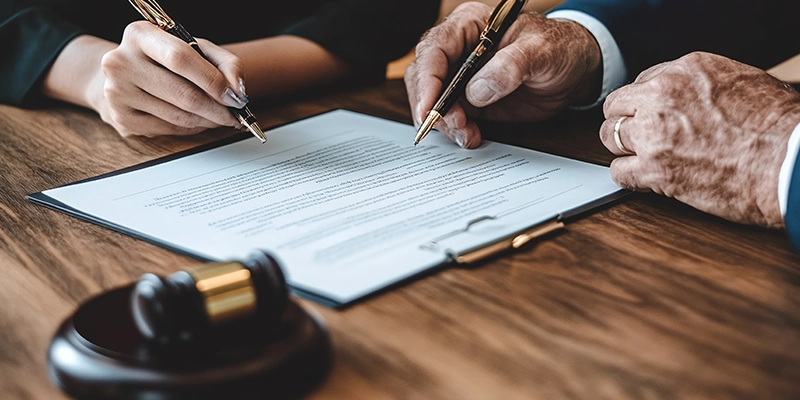By James Parker
The Supreme Court waited 27 years after deciding the 1994 landmark case of Cambell v. Acuff Rose to revisit the issue of fair use in Google LLC v. Oracle America Inc. Decided in 2021, the court took an expansive view of the doctrine of fair use, agreeing that Google “reimplemented,” technology in a new context.[1] Now, less than two years later, the Court in Warhol Foundation v. Goldsmith is again considering the scope of the fair use doctrine in copyright law. Center for Art Law has followed the case with great interest, written at great length on the issue of fair use,[2][3][4] and has covered the oral arguments made by both sides of the Warhol v. Goldsmith controversy; this article revisits the facts of the matter as well as attempts to explore the possible ramifications ahead of the Supreme Court’s decision.[5]
Following three years of litigation, the Andy Warhol Foundation (AWF) successfully petitioned the Supreme Court to review a copyright infringement case that has garnered the attention of the public as it made its way from trial to the court of appeals. At its center is a decades-old photograph of the pop star Prince, a series of pieces by Andy Warhol based on that same image, and the doctrine of fair use.
“Let the little things that would ordinarily bore you suddenly thrill you,” said Andy Warhol, visual artist and champion of the pop art movement.[6] Beginning his career at a time when beauty embraced realism and elevation, Warhol couched his philosophy in the exact opposite by finding beauty in the mundane and the ordinary.[7] Warhol’s musings remind us of the axiomatic, that inspiration can be found anywhere, and could even allude to a cornerstone of copyright law that receives all that which has been sufficiently transformed as artistic creation.
The controversy stems back to 1984 when Vanity Fair decided to publish an article about Prince in a magazine.[8] Vanity Fair reached out to a licensing agency that managed Lynn Goldsmith, a celebrated rock photographer, in search of a photograph of Prince.[9] The agency, on a one time basis, granted the use of a particular photograph.[10] Vanity Fair then commissioned Andy Warhol, just three years before he died, to create a piece to accompany the article based on the licensed photo.[11] Warhol made a number of screen prints, though only one was selected for the Vanity Fair article.[12]
Prince died in 2016 and Vanity Fair decided to publish a special article about his legacy as an artist.[13] Vanity Fair then contacted the Andy Warhol Foundation, a New York nonprofit that licenses the artist’s works.[14] It was during this exchange that Vanity Fair learned that Warhol had created multiple prints based on the Goldsmith photo of Prince provided in 1984 for the original article.[15] Vanity Fair then chose a different screen print of the selection to use in their special article.[16] Goldsmith saw the special issue and contacted the Andy Warhol Foundation about her copyright claim and immediately registered the photo of Prince as an unpublished work (VAU001277562 / 2016-11-17).[17]
Preemptively, the Andy Warhol Foundation sued for declaratory judgment, confident that the work selected had been sufficiently transformed and was not substantially similar, thus avoiding infringement of Goldsmith’s copyright.[18] The trial court granted the foundation’s motion for summary judgment claiming fair use and denied Goldsmith’s cross motion for summary judgment claiming copyright infringement.[19] The trial court reasoned that Warhol’s treatment of the Prince image conveyed new meaning and message noting numerous artistic differences, particularly Warhol taking no more than what was necessary for his transformation.[20]
Goldsmith appealed the trial court’s ruling and brought their reasoning before a panel.[21] Contrary to the trial court’s decision, the panel found that the photograph was not transformative and concluded, in addition, that judges are ill-suited to decide “the meaning or message” of art works.[22] The panel provided that, in assessing the degree of transformation a piece has undergone, judges must compare the pieces side by side and consider, if outside of the artist’s intent, whether the resulting work is fundamentally different and new.[23]
Using the test enumerated above, the panel concluded that Warhol’s Prince Series still retained essential elements of its source material and the Goldsmith photo, despite the artist’s attempts to imbue it with new meaning, remains the recognizable foundation of the piece.[24] The panel further reasoned that while the pieces occupy different markets, Warhol’s rendition still harms Goldsmith’s ability to license the photo to publications and to other artists so that they might create derivative works.[25]
Individuals and organizations alike wrote amicus briefs ahead of the case’s arrival to the Supreme Court. Most notably, the Copyright Office, based in Washington D.C., has aligned itself with the National Press Photographers Association and the American Society of Media Photographers backing Goldsmith and urging the court to rule in her favor. Collectively, they advance that “the fair use defense was never meant to give infringers a pass so long as they claim some new subjective ‘meaning or message’ in their derivative use regardless of how it is used … [AWF’s] argument that a derivative use of a copyrighted work should be found ‘transformative’ so long as it adds any cognizable echo of ‘new meaning or message’ ignores the plain language of the Act and invites the fair use exception to swallow the derivative use rule.”[26]
Conversely, museums, professors of art and law, and organizations such as the Robert Rauschenberg Foundation and the Roy Lichtenstein Foundation have drafted amicus briefs in favor of AWF. Overwhelmingly, they emphasize the importance of copying to visual art and its link to creativity.[27] Those siding with AWF argue that they intend to protect artistic progress, and by consequence, they recognize that artists must have room to build on, be inspired by, and transform works that came before them.[28]
At present, Chapter 17 of the United States Code provides that copyright protection “subsists, in … original works of authorship fixed in any tangible medium of expression.”[29] The standard for originality is not expressly provided for in Chapter 17. The court in Bleistein v. Donaldson, however, ruled that original meant “created organically by an author [with] some degree of creativity.”[30] 17 USC 102(a) define works of authorship as literary works, musical works, dramatic works, pantomimes and choreographic works, pictorial graphic and sculptural works, motion pictures, audiovisual works, sound recordings, and architectural works.[31] Finally, fixed, according to 17 USC 101, means “perm[inence] or [the ability] to be perceived, reproduced, or otherwise communicated for a period of more than transitory duration.”[32]
The fair use provision, Section 107 of the Copyright Act, states:
Notwithstanding the provisions of section 106 and 106a, the fair use of a copyrighted work, including such use by reproduction in copies or phonorecords or by any other means specified by that section, purposed such as criticism, comment, news reporting, teaching (including multiple copies for classroom use), scholarship, or research, is not an infringement of copyright. In determining whether the use made of a work in any particular case is a fair use the factors to be considered shall include – (1) the purpose and character of the use, including whether such use is of a commercial nature or is for nonprofit educational purposes; (2) the nature of the copyrighted work; (3) the amount and substantiality of the portion used in relation to the copyrighted work as a whole; and (4) the effect of the use upon the potential market for or value of the copyrighted work.[33]
Whether you find yourself siding with Goldsmith or AWF, it is important to acknowledge the implications of the Supreme Court should it decide against adhering to its own standard. Primarily, a decision contrary to precedent puts the onus on judges to inspect the similarity of two works of art. Should the judge be unable to look past visual similarities then the argument is moot, regardless of training or expertise.[34] Historically, art is filled with pieces that are similar since aspiring artists naturally study the works of masters and those they look up to. What is more insidious and harrowing, however, is the sudden triumph of copyright over the right to free speech, where the Supreme Court has made it clear time and again that it is inviolable.[35] A ruling in favor of Goldsmith allows copyright to overreach, thus chilling the rights of artists who express themselves through image. The doctrine of fair use is just as germane to copyright as it is to free speech.
It is important to understand that while AWF has raised fair use as a defense to copyright infringement, it is more than an affirmative defense. Fair use is the crux of copyright. If the purpose of the copyright clause in our constitution is to encourage the continued proliferation of creative works then fair use ensures that artists can create new works that continuously build on the works of their predecessors and draw inspiration from the world around them – this is the essence of creativity and the goal of copyright law itself. As the Supreme Court has enunciated in the past, fair use is a first amendment “safeguard,” functioning to ensure that copyright is an engine to freedom of expression, not a hindrance.[36]
About the Author:
James Parker is a recent graduate of New York Law School, class of 2022. While in law school most of his studies orbited Intellectual Property law drawing a particular interest in copyright. Parker recently sat for and passed the July 2022 administration of the Bar and is Center for Art Law’s current Judith Bresler Fellow.
Suggested Readings :
- Campbell v. Acuff-Rose Music, Inc., 510 U.S. 569, 114 S. Ct. 1164, 127 L. Ed. 2d 500 (1994). https://www.newyorker.com/magazine/2020/06/08/untangling-andy-warhol
- Christophe Geiger, Freedom of Artistic Creativity and Copyright Law: A Compatible Combination?, 8 U.C. Irvine L. Rev. 413 (2018). Available at: https://scholarship.law.uci.edu/ucilr/vol8/iss3/3
- GOOGLE LLC v. Oracle America, Inc., 141 S. Ct. 1183, 593 U.S., 209 L. Ed. 2d 311 (2021).
- Campbell v. Acuff-Rose Music, Inc., 510 U.S. 569, 114 S. Ct. 1164, 127 L. Ed. 2d 500 (1994). ↑
- Kaiser, Laura M. “Case Review: Rock’n’Roll, Museums, and Copyright Law (2020).” Center for Art Law, Center for Art Law , 19 Mar. 2021, https://itsartlaw.org/2021/03/19/case-review-rocknroll-museums-and-copyright-law-2020/#post-57033-footnote-3. ↑
- Campbell, Sekou. “Artists, Not Judges, Should Decide Fair Use: Select Implications of the Cariou-Sconnie Nation Deviation.” Center for Art Law, Center for Art Law , 5 Dec. 2019, https://itsartlaw.org/2015/04/02/fair-use-implications-cariou-sconnie-nation-division/. ↑
- “Green Day Wins Fair Use Claim.” Center for Art Law, Center for Art Law, 5 Dec. 2019, https://itsartlaw.org/2013/08/09/greenday-wins-fair-use-claim/. ↑
- Farmer, Jana S, et al. “Appropriation Art on Trial: Oral Arguments before the Supreme Court in Warhol v. Goldsmith.” Center for Art Law, Center for Art Law , 22 Oct. 2022, https://itsartlaw.org/2022/10/22/warhol-v-goldstein-ussupct/. ↑
- Rise Art. “Andy Warhol Quotes.” Rise Art, Rise Art, 29 Oct. 2020, https://www.riseart.com/guide/2396/andy-warhol-quotes. ↑
- Acocella, Joan. “Untangling Andy Warhol.” The New Yorker, The New Yorker, 1 June 2020, https://www.newyorker.com/magazine/2020/06/08/untangling-andy-warhol. ↑
- Andy Warhol Foundation v. Goldsmith, 11 F.4th 26 (2d Cir. 2021). ↑
- Id at 34. ↑
- Id. ↑
- Id. ↑
- Id. ↑
- Id at 35. ↑
- Id. ↑
- Id. ↑
- Id. ↑
- Rutledge, Virginia. “The Stakes of a Copyright Case Being Heard by the US Supreme Court Go Way Beyond Andy Warhol.” The Art Newspaper – International Art News and Events, The Art Newspaper , 6 May 2022, https://www.theartnewspaper.com/2022/05/06/its-not-all-about-andy-warhol-its-about-you. ↑
- Id. ↑
- Andy Warhol Foundation v. Goldsmith, 382 F. Supp. 3d 312 (S.D.N.Y. 2019). ↑
- Id at 326. ↑
- Andy Warhol Foundation v. Goldsmith, 11 F.4th 26 (2d Cir. 2021). ↑
- Id. at 37. ↑
- Id. at 42. ↑
- Id. at 43. ↑
- Id at 50. ↑
- Brief for the American Society of Media Photographers et al. as Amicus Curiae Supporting Respondents, Andy Warhol Foundation for the Visual Arts, Inc. v. Goldsmith, No. 21-869 (2nd Cir. Oct. 12, 2022). ↑
- Rutledge, supra, note 17. ↑
- Id. ↑
- 17 U.S.C. §102 (1976). ↑
- Bleistein v. Donaldson Lithographing Co., 188 U.S. 239. ↑
- 17 U.S.C. §102(a) (1976). ↑
- 17 U.S.C. §101 (1976). ↑
- 17 U.S.C. §107 (1976). ↑
- Rutledge, supra, note 17. ↑
- Id. ↑
- Harper & Row, Publishers, Inc. v. Nation Enterprises, 471 U.S. 539, 105 S. Ct. 2218, 85 L. Ed. 2d 588 (1985). ↑
The post Degrees of Transformation: Andy Warhol’s 102 minutes of fame before the Supreme Court appeared first on New.




